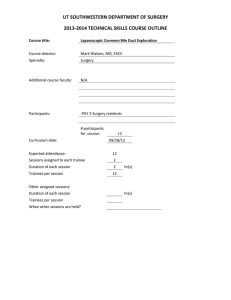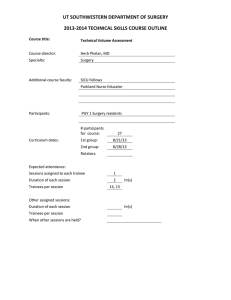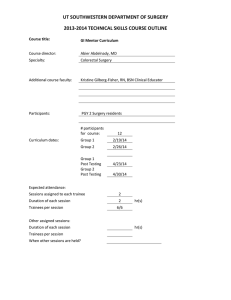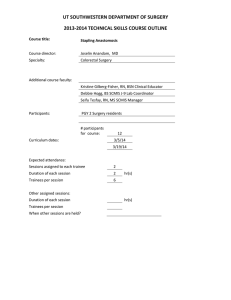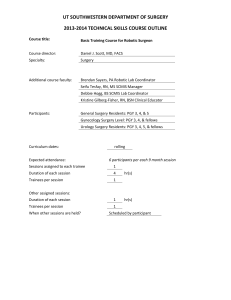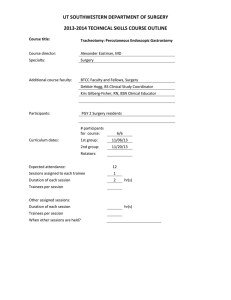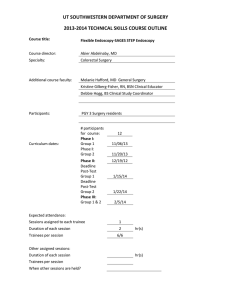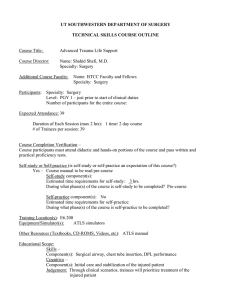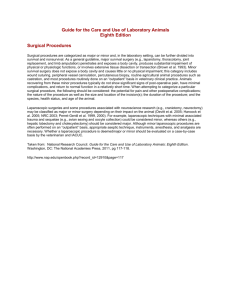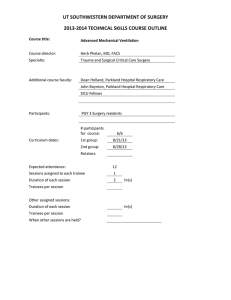UT SOUTHWESTERN DEPARTMENT OF SURGERY 2013-2014 TECHNICAL SKILLS COURSE OUTLINE
advertisement
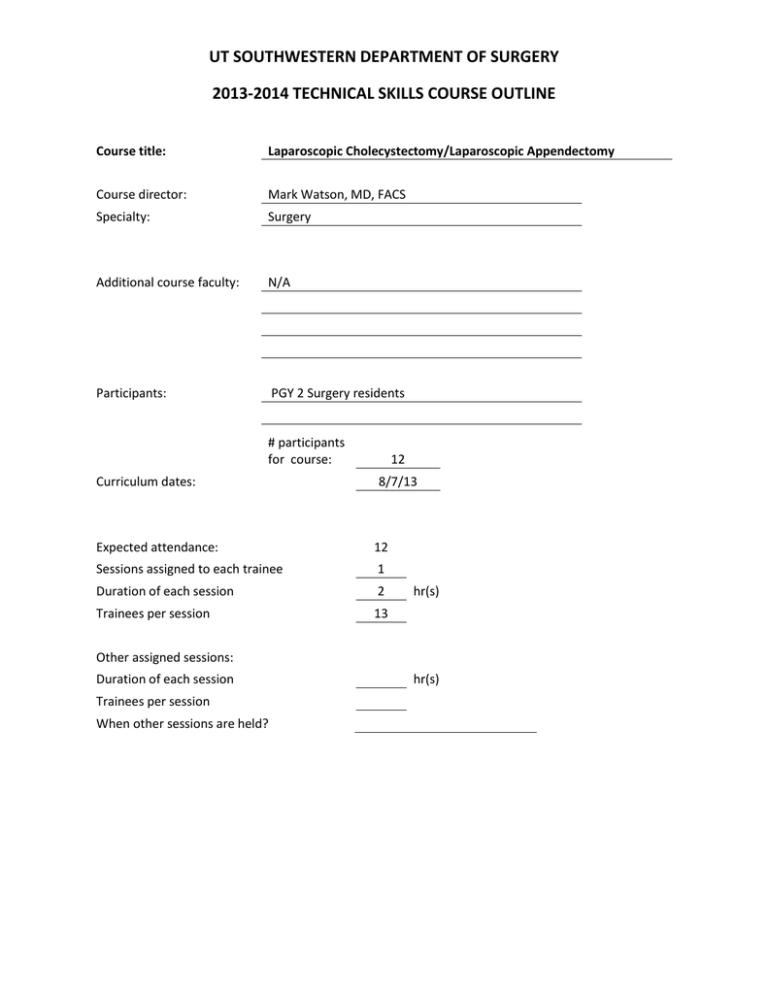
UT SOUTHWESTERN DEPARTMENT OF SURGERY 2013-2014 TECHNICAL SKILLS COURSE OUTLINE Course title: Laparoscopic Cholecystectomy/Laparoscopic Appendectomy Course director: Mark Watson, MD, FACS Specialty: Surgery Additional course faculty: N/A Participants: PGY 2 Surgery residents # participants for course: Curriculum dates: 12 8/7/13 Expected attendance: 12 Sessions assigned to each trainee 1 Duration of each session 2 Trainees per session 13 hr(s) Other assigned sessions: Duration of each session Trainees per session When other sessions are held? hr(s) UT SOUTHWESTERN DEPARTMENT OF SURGERY 2013-2014 TECHNICAL SKILLS COURSE OUTLINE Course Completion Verification - How do you know when a trainee has completed each component of the course and the overall course itself? Please specify for each course component, if applicable – for example, assigned reading component verified by written testing and skills component verified by attending 2 course-instructor led sessions. ☒ ☐ Attendance based: based on trainee attending all of the designated sessions ☐ Entire course - course solely based on attendance ☒ Part of course - attendance to designated sessions required in addition to other components listed below Repetition based: based on the trainee performing a specific number of repetitions Components: # of Repetitions: ☐ Proficiency based: based on the trainee performing a specified number of repetitions Components: Method for determining: ☒ ☐ Written testing: based on passing a written test Components: Dr. Watson Lap Appy/Lap Chole 12 question test, must be passed with score of 75% Documentation of watching videos/CD's/web-based materials: based on proctor or instructor verification that the trainee has watched the specified materials Components: ☐ Other (specify): Components: UT SOUTHWESTERN DEPARTMENT OF SURGERY 2013-2014 TECHNICAL SKILLS COURSE OUTLINE Self-study or self-practice (Is self-study or self-practice an expectation of this course?) ☐ No ☒ Yes Self-study component(s): Review selected readings Estimated time requirements for self-study: 2 hrs Phase of course where self-study completed: Prior to session Self-practice component(s): Estimated time requirements for self-practice: hrs Phase of course where self-study completed: Training Location(s): E6.200 Multi-Modality Education and Videoconference Center Resources (Textbooks, CD-ROMs, Videos, etc): (Articles will be sent electronically to participants 2 weeks prior to course) Journal-American College of Surgeons (2005) 604-611. “Biliary Injury in Laparoscopic Surgery: Part 2. Changing the Culture of Cholecystectomy” by Steven M. Strasberg, MD Journal-Hepatobiliary Pancreatic Surgery (2002) 543-547. “Avoidance of biliary injury during laparoscopic cholecystectomy” by Steven M. Strasberg, MD Educational Scope: ☐ ☒ ☒ Skills Components: Cognitive Components: Judgment Components: 4 Skills Models stations , components to practice. Identification of anatomic structures, safe dissection of the gallbladder and appendix. Understanding of dissection to allow completion of procedure and avoidance of postoperative complications. Distinguishing appropriate candidates for laparoscopic vs. open surgical dissection. UT SOUTHWESTERN DEPARTMENT OF SURGERY 2013-2014 TECHNICAL SKILLS COURSE OUTLINE Learning Objectives: Understanding safe laparoscopic access for cholecystectomy and appendectomy. Knowledge of appropriate instruments for dissection of gallbladder and appendix. Understanding appropriate situations for conversion to open surgery. Understanding management of common surgical complications. Summary of Curriculum, Teaching Methods, and Resource Utilization: (For each component, please specify what material will be taught during each session, how will the material be taught, and what teaching materials will be used. Please also specify the overall format for the course including expectations required for successful course completion) Interactive video presentation of each operation, feedback from participants and faculty. Use of teleconferencing center resources with multiple views and projections of procedures. (model stations) Methods for giving feedback to learners (Formative and Summative): Direct instructor interaction and feedback during session Methods of assessment of learners: Assessment will be direct interaction and responses from residents during session. Post lecture exam, incorrect answers will be reviewed with participant for clarification. Methods for remediation: One-on-one remediation is applicable Methods of course evaluation: Post-test questionnaires completed by trainees at the end of the course and faculty evaluations of skills sessions Materials: N/A
